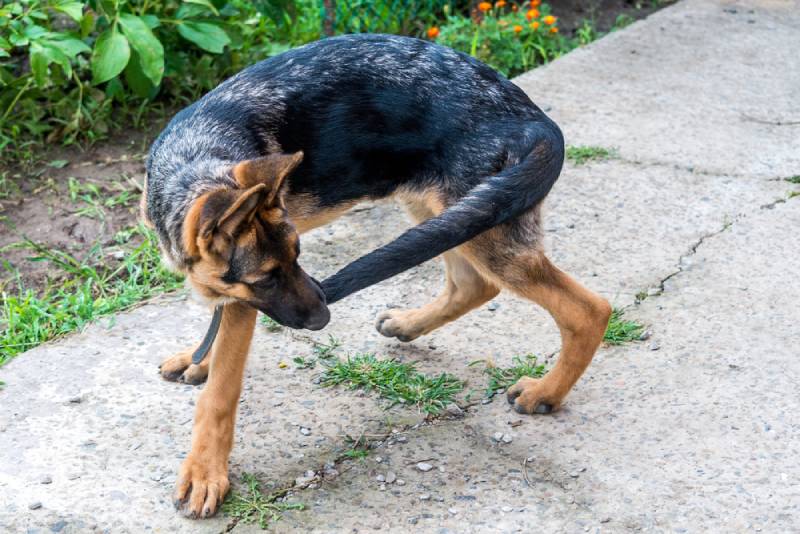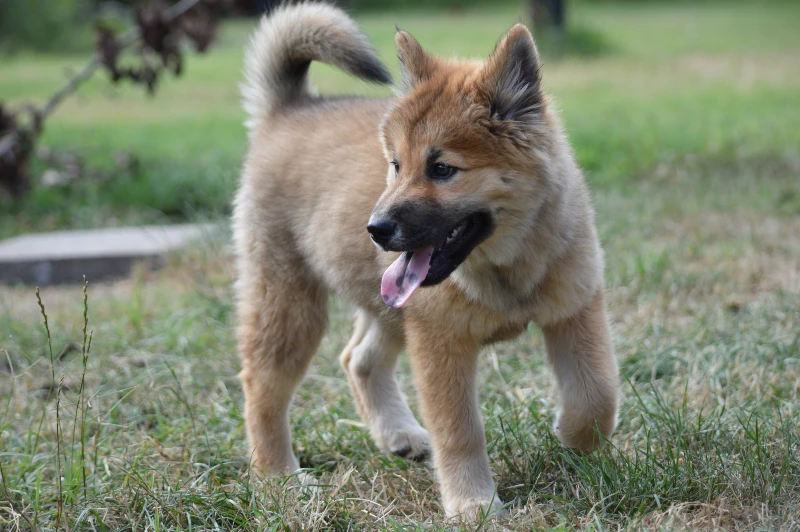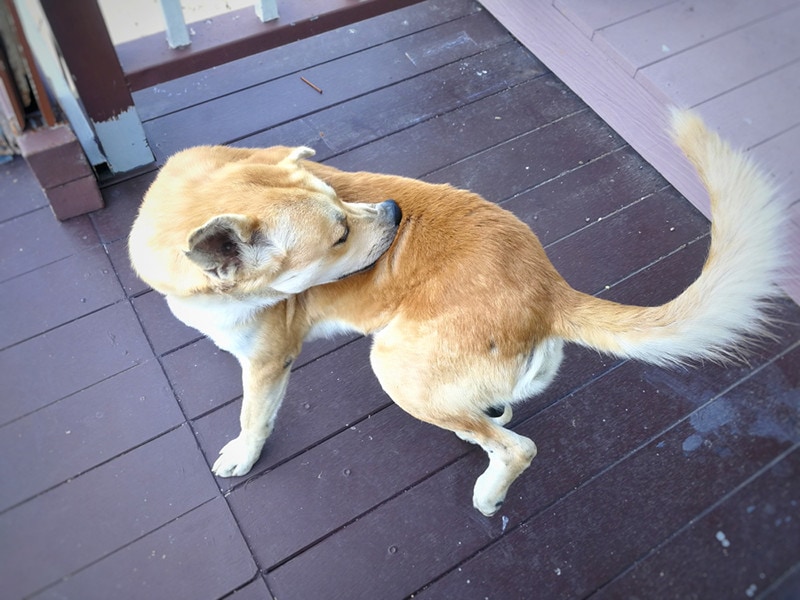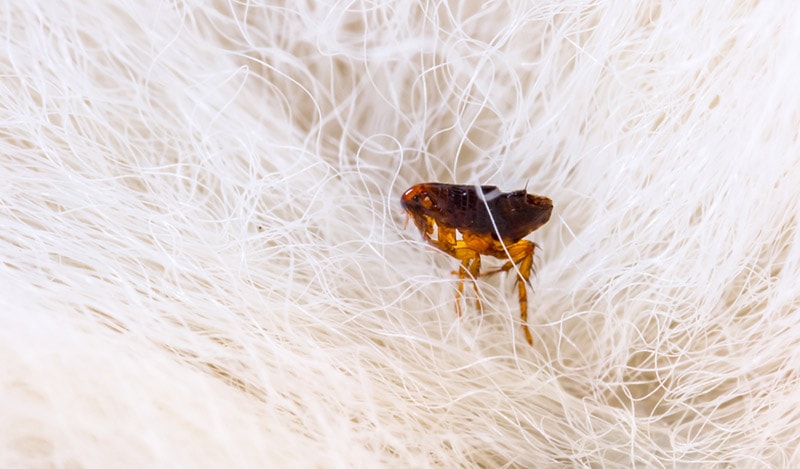Why Do Dogs Chase Their Tails? 9 Typical Reasons

Updated on

Anyone who enjoys keeping a canine companion can attest that dogs sometimes exhibit peculiar behaviors. One of the most popular canine routines includes running in circles in an endless chase of their tails.
While this behavior is often harmless, it can also cause concern. For puppies, this is normal behavior and is usually a sign of playfulness. Adult dogs also occasionally chase their tails when bored or looking for attention. However, constant tail chasing and biting may indicate underlying psychological or health issues that should prompt a visit to the vet.
In this article, we will discuss the reasons behind this tail-chasing behavior and what you should do about it. Read on to learn more.
The 9 Reasons Why Dogs Chase Their Tails
1. Play
This behavior is more prevalent in puppies than it is in adult dogs. Puppies mostly spend time learning about their bodies and exploring their immediate environment. Therefore, chasing after their tails makes some sense because new puppies don’t know these appendages are attached to their bodies. To them, a tail is simply something fascinating that they can chase. So, this behavior in young pups shouldn’t be considered profound or serious.
If your young dog displays this behavior, watch him closely. If it can catch its tail, it will attempt to bite it, which will be a very painful affair. So, ensure you monitor the situation and apply corrective measures when necessary. It is best to stop this behavior while the pup is still young before you spend countless hours at your vet’s office.

2. Pain
Just as humans experiencing discomfort or pain would rub the affected area or take pain medication for relief, so do dogs. But, since dogs can’t exactly grab some Tylenol for pain relief, they bite the affected areas instead.
Usually, pain in the tail area is caused by traumatic injuries. However, it can be brought on by chronic conditions such as anal gland issues or arthritis. Infections can also prompt your dog to nip or bite the painful area. Common signs of infections include itching, redness, missing fur patches on the coat, and a foul-smelling discharge.
When your dog is in pain, it is likely to display signs such as limping, holding its tails low to the ground, slower walks and even avoiding jumping or running.
Most infection signs cannot dissipate without the intervention of prescription antibiotics. Moreover, a qualified professional should be able to pinpoint the exact cause and location of the dog’s pain and discomfort and recommend the appropriate treatment.
3. Compulsive Behavior
Did you know some dogs can suffer from obsessive-compulsive disorders (OCD)? Indeed, they can! In fact, according to data from the American Veterinary Medical Association1, OCD in animals is a serious welfare issue with negative consequences for their health and general well-being.
Compulsive behavior is a repetitive thought or action that people and animals suffering from OCD frequently engage in to reduce stress levels. Unfortunately, this behavior can be detrimental to their health.
A dog constantly chasing after its tail might be engaging in compulsive behavior related to OCD. So, schedule a vet appointment to rule out any underlying health problems.

4. Stress
Whenever dogs feel nervous, anxious, or stressed, they tend to engage in repetitive behavior to help them calm down. While humans might choose to go for a walk or do some deep breathing exercises or stretches to relieve their stress, dogs chase after their tails to relieve their anxiety and stress levels.
So, a dog will start chasing after his tail whenever he feels anxious.
Common causes of stress and anxiety in dogs include kennel living, lack of socialization opportunities, aggression from other pets and animals, previous trauma, or even emotional and physical abuse by their owners. A dog that has experienced any of these things is likely to develop tail-chasing behavior.
Therefore, if you suspect your mutt’s tail chasing is stress-related, try to find out what might be aggravating him and find ways to make him more relaxed at home. This might cause the tail-chasing behavior to dissipate completely.
5. Irritation From Parasites
If your furry companion suddenly develops an interest in scratching his hind side, parasites and pests may be the culprits. Parasites such as ticks and fleas tend to be very itchy to a dog and commonly congregate towards the rear end.
Since dogs can’t exactly reach back and scratch the affected area, they tend to use their teeth. So, if the parasites are in the tail region, your dog will be running around in circles in a bid to catch the tail and alleviate the itching.
Additionally, intestinal parasites can also be responsible for intense anal itching that might prompt your dog to excessively gnaw at the area. These parasites are also why some dogs are fond of dragging their behinds across the floor.
If your dog tries to chase after its tail while also dragging his butt across the floor, you should first inspect the tail for obvious signs of parasites. Your vet might also recommend treatment options such as oral or topical flea medications or a flea collar.

6. Cognitive Issues
Tail-chasing behavior in dogs can also result from brain abnormalities that inhibit cognitive function. These abnormalities can be caused by birth defects or even tumors. They could also be caused by a cognitive decline that is age-related.
Signs indicating cognitive issues that you should be on the lookout for include seizures, poor coordination, constant head tilting, asymmetrical facial expressions, and sudden drastic changes in personality or behavior.
The treatment options for cognitive issues will ultimately depend on the underlying root cause. So, if you notice any of the above-mentioned signs, schedule an appointment with your local vet to help you identify and manage the neurological conditions.
7. Allergies
Sometimes, the tail-chasing and biting behavior is brought on by allergies. Like in most pets, allergies in dogs manifest themselves as skin problems. You will notice some red skin, welts, scales, and other obvious signs of allergies on your dog’s coat.
Usually, allergies in dogs are brought on by a change in diet or even getting their tails stuck in a poison ivy bush. If you notice any of the allergy signs, schedule a visit with your vet. By identifying and isolating the root cause of the reaction on time, the happier your canine companion will be.

8. Boredom
Naturally, canines get excited when they catch a glimpse of their tail wagging around. Once they do, they will be tempted to chase after it because it may seem easier to catch than chasing after smaller and faster rodents. After some time, this occasional behavior can gradually escalate into a habit.
This behavior is more prevalent in high-energy dogs regularly left alone at home for a significantly long period. Even tailless dogs can adopt the spinning habits when bored.
If your dog plays with his tail once every while, then you shouldn’t be worried about the behavior. However, if your dog spends most of his waking time tail chasing, you might need to look for a suitable outlet for their pent-up energy. This could be in the form of interactive toys or adding another dog into your household to be a playmate.
However, if trying to redirect your dog’s attention from his tail or providing a playmate doesn’t seem to work, it’s probably time to seek professional help.
9. Attention Seeking
If your dog is not receiving enough attention, he is likely to engage in activities that can evoke a response. One such way that a dog tries to get the parent’s attention is by chasing after his tail.
To canines, any action that evokes a response from the owner is good, even if you reprimand the dog. So, it is vital that you schedule some time out of your busy schedule to spend quality time with your dog.
Most dog breeds are very sociable and thrive with plenty of social interactions with their human companions.

Conclusion
Random tail-chasing behavior in dogs is not always a cause for concern. Dogs occasionally do so to amuse themselves when feeling bored or to relieve an itch on their rear end.
However, if your dog is majorly fixated on his tail, he could be experiencing pain and discomfort caused by allergies, infections, illnesses, or parasites. These concerns need medical intervention from a certified professional.
Since repeated tail-chasing behavior can have negative consequences on a dog’s overall health, you should try to get to the root cause to put your mutt into a fast-healing track. Sure, you can giggle at the dog’s play antics but do not ignore any potential underlying issues altogether. Always strive to give your dog a happy and healthy life.
Featured Image Credit: Tatyana Blinova, Shutterstsock











